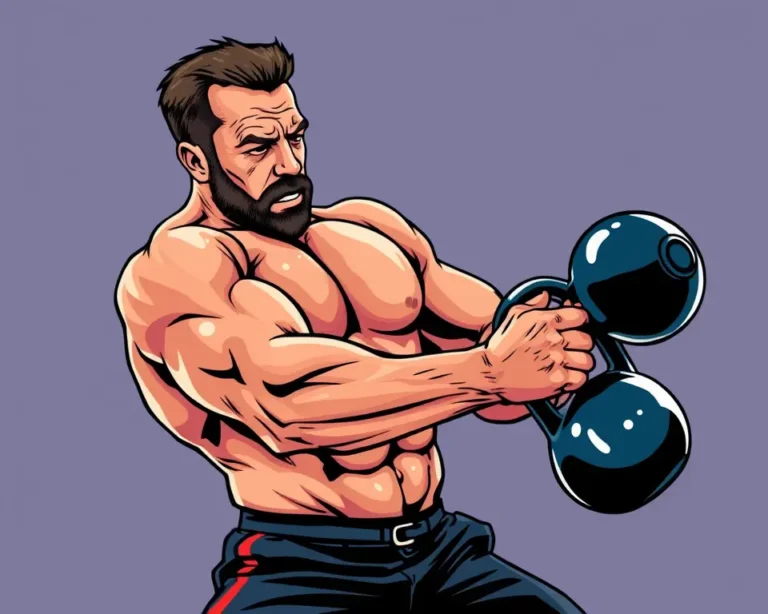Joe Rogan, the well-known podcaster, comedian, and UFC commentator, is also a dedicated fitness enthusiast. He’s a big proponent of kettlebell training, and his workouts are designed to build strength, size, and endurance. What sets Rogan’s approach apart is his emphasis on avoiding training to failure. This method allows for consistent progress, reduces the risk of injury, and prevents burnout. This article dives into a kettlebell workout inspired by Joe Rogan, explaining the exercises, the benefits, and why you might want to ditch the “go hard or go home” mentality.
Why Kettlebells?
Kettlebells are a versatile and effective tool for building overall fitness. They offer a unique combination of strength training and cardiovascular conditioning. Here are some benefits of kettlebell training:
- Full-Body Workout: Kettlebell exercises engage multiple muscle groups simultaneously, providing a comprehensive workout. They work both the upper and lower body, as well as the core [4, 20].
- Strength and Power: Kettlebell training develops both strength and explosive power. Exercises like swings and snatches require you to generate force quickly, improving athletic performance [4, 5].
- Cardiovascular Fitness: Kettlebell workouts can elevate your heart rate and improve cardiovascular health. The dynamic movements and the need to stabilize the weight provide a cardio challenge [1, 4].
- Core Strength: Many kettlebell exercises require significant core engagement to maintain stability and control. This leads to improved core strength and stability [5, 17].
- Improved Mobility and Flexibility: The flowing movements in kettlebell workouts can enhance joint mobility and flexibility. Starting with lighter weights can gradually build strength and protect the muscles around the joints [5].
- Grip Strength: Handling kettlebells can improve grip strength, which is important for many activities [5, 8].
- Versatility: A single kettlebell can be used for a wide variety of exercises, making it a cost-effective and space-saving fitness tool [5, 6].
The Joe Rogan Kettlebell Philosophy: Avoiding Failure
Many traditional workout programs push you to the limit, encouraging you to perform as many repetitions as possible until you can’t do another one with good form. This is known as training to failure. While it can be effective for building muscle, it also has some drawbacks:
- Increased Risk of Injury: Training to failure can compromise your form, increasing the risk of injury [14, 21].
- Longer Recovery Time: Pushing your muscles to their absolute limit requires a longer recovery period, potentially hindering your ability to train consistently [14, 21].
- Burnout: Constantly pushing yourself to failure can lead to mental and physical burnout, making it difficult to stick to your workout routine [13, 14].
Joe Rogan advocates a different approach: using weights that challenge you but stopping short of failure. This allows you to:
- Maintain Good Form: By avoiding failure, you can focus on maintaining proper technique throughout the exercise, reducing the risk of injury [13, 14].
- Train More Frequently: Because you’re not completely exhausting your muscles, you can recover more quickly and train more often [13, 14].
- Prevent Burnout: A less intense approach can be more sustainable in the long run, helping you stay consistent with your workouts [13, 14].
The Joe Rogan-Inspired Kettlebell Workout
This workout is inspired by Joe Rogan’s kettlebell routine, focusing on compound exercises that build strength and size without pushing you to absolute failure. Adjust the weight and reps according to your fitness level.
Warm-up (3 sets)
- Squats: 20 reps [7, 16]
- Push-ups: 20 reps [7, 16]
Workout (3-5 sets)
- Kettlebell Swings: 20 reps [2, 15]
- Kettlebell Clean and Press: 5 reps per arm [7, 16]
- Windmill: 5 reps per arm [2, 15]
- Chin-Ups: 5 reps [2] or Dead Hangs for 30-60 seconds [2]
- Overhead Squats: 5 reps [2]
Detailed Exercise Instructions
- Kettlebell Swings:
- Stand with your feet shoulder-width apart, with the kettlebell a foot in front of you [2, 15].
- Hinge at your hips, pushing your hips back and keeping your back straight [2, 15].
- Grasp the kettlebell with both hands, and hike it back between your legs [2, 15].
- Explosively drive your hips forward, swinging the kettlebell up to chest height [2, 15].
- Allow the kettlebell to swing back down between your legs, and repeat [2, 15].
- Kettlebell Clean and Press:
- Stand with your feet shoulder-width apart, with the kettlebell in front of you [7, 16].
- Hinge at your hips and grab the kettlebell with one hand [7, 16].
- Clean the kettlebell by pulling it up and rotating your wrist so that the kettlebell rests on your forearm in the “rack position” [7, 16].
- Press the kettlebell overhead, fully extending your arm [7, 16].
- Lower the kettlebell back to the rack position, and then back to the ground. Repeat on the other arm [7, 16].
- Windmill:
- Stand with your feet slightly wider than shoulder-width apart [2, 15].
- Clean and press a kettlebell overhead, fully extending your elbow [2, 15].
- Turn your feet 45 degrees away from the kettlebell [2, 15].
- Keeping the leg on the kettlebell side as straight as possible, hinge at your hips and slide your free hand down the inside of your front leg [2, 15].
- Try to touch the floor while keeping your torso parallel to it and your gaze fixed on the kettlebell [2, 15].
- Engage your hips to return to a standing position. Repeat on the other arm [2, 15].
- Chin-Ups:
- Grasp a chin-up bar with an underhand grip, shoulder-width apart [2].
- Lift your feet from the floor, hanging freely with straight arms [2].
- Pull yourself up by flexing the elbows. When your chin passes the bar, pause before lowering to the starting position [2].
- Alternatively, perform dead hangs to stretch your back and shoulders while building grip strength [2].
- Overhead Squats:
- Stand with your feet shoulder-width apart [2, 15].
- Press one or two kettlebells overhead [2, 15].
- Maintain a tall spine as you squat as deeply as possible [2, 15].
- Drive back up to a standing position [2, 15].
Important Considerations
- Proper Form: Focus on maintaining proper form throughout each exercise. If you’re new to kettlebells, consider working with a qualified trainer to learn the correct techniques [4].
- Weight Selection: Choose a weight that challenges you but allows you to complete the exercises with good form and without reaching failure [1, 4].
- Listen to Your Body: Pay attention to your body and rest when needed. Don’t push through pain [1, 4].
- Progression: As you get stronger, gradually increase the weight or the number of sets and reps [1, 4].
- Rest: Rest as needed between sets to maintain proper form and safety [2].
Benefits of This Workout
- Increased Strength and Muscle Mass: This workout targets major muscle groups, leading to increased strength and muscle mass [1, 4].
- Improved Conditioning: The combination of strength training and dynamic movements improves cardiovascular fitness [1, 4].
- Enhanced Core Stability: Many of the exercises require significant core engagement, leading to improved core stability and balance [5, 17].
- Functional Fitness: Kettlebell exercises mimic real-life movements, improving functional fitness and making everyday activities easier [5, 10].
- Reduced Risk of Injury: By avoiding training to failure, this workout reduces the risk of injury and promotes long-term sustainability [13, 14].
Adapting the Workout to Your Fitness Level
This workout can be adapted to suit different fitness levels.
- Beginner: Start with lighter weights and fewer sets (3 sets). Focus on mastering the proper form before increasing the weight or volume. Consider using variations of the exercises that are less challenging, such as knee push-ups instead of full push-ups [7].
- Intermediate: Use moderate weights and perform 3-4 sets of each exercise. Focus on maintaining good form and gradually increasing the weight as you get stronger.
- Advanced: Use heavier weights and perform 4-5 sets of each exercise. You can also increase the challenge by adding variations of the exercises, such as single-leg deadlifts or overhead squats with two kettlebells [2, 17].
Final Thoughts
Joe Rogan’s approach to kettlebell training offers a sustainable and effective way to build strength, size, and endurance. By avoiding training to failure, you can reduce the risk of injury, train more frequently, and prevent burnout. This workout is a great starting point, but remember to listen to your body, focus on proper form, and gradually increase the challenge as you get stronger. Embrace the kettlebell, ditch the “failure” mindset, and get ready to transform your fitness.







